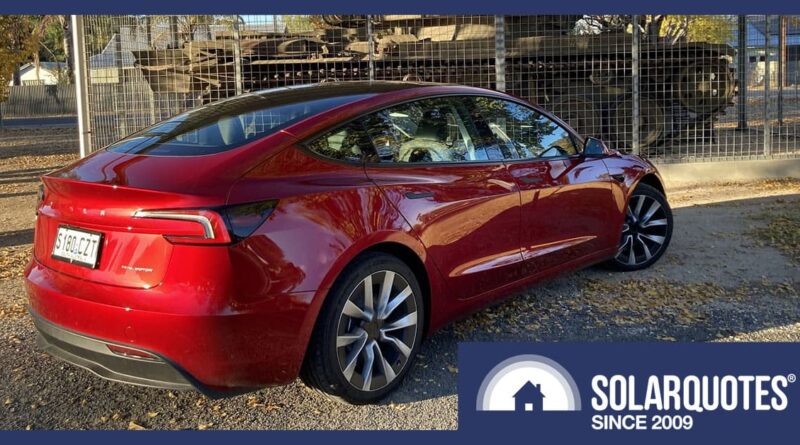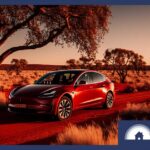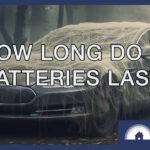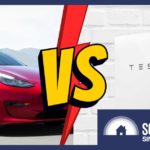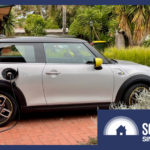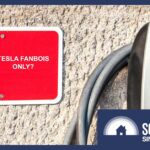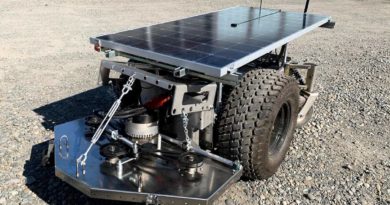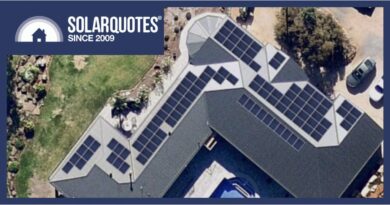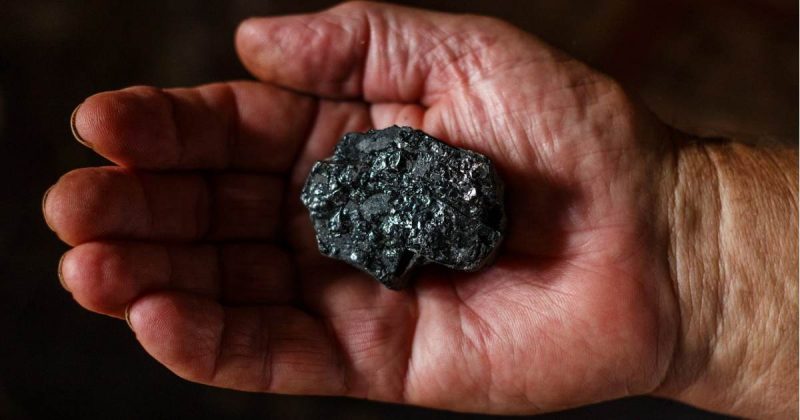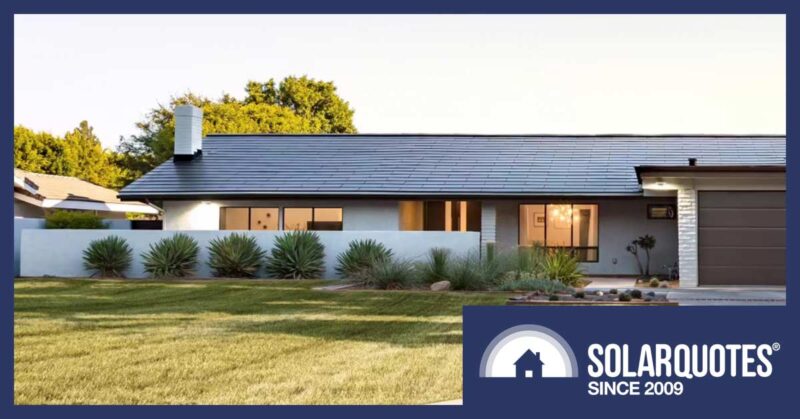The Refreshed Tesla Model 3 Is A Damn Fine Car – With One Major Elon Error
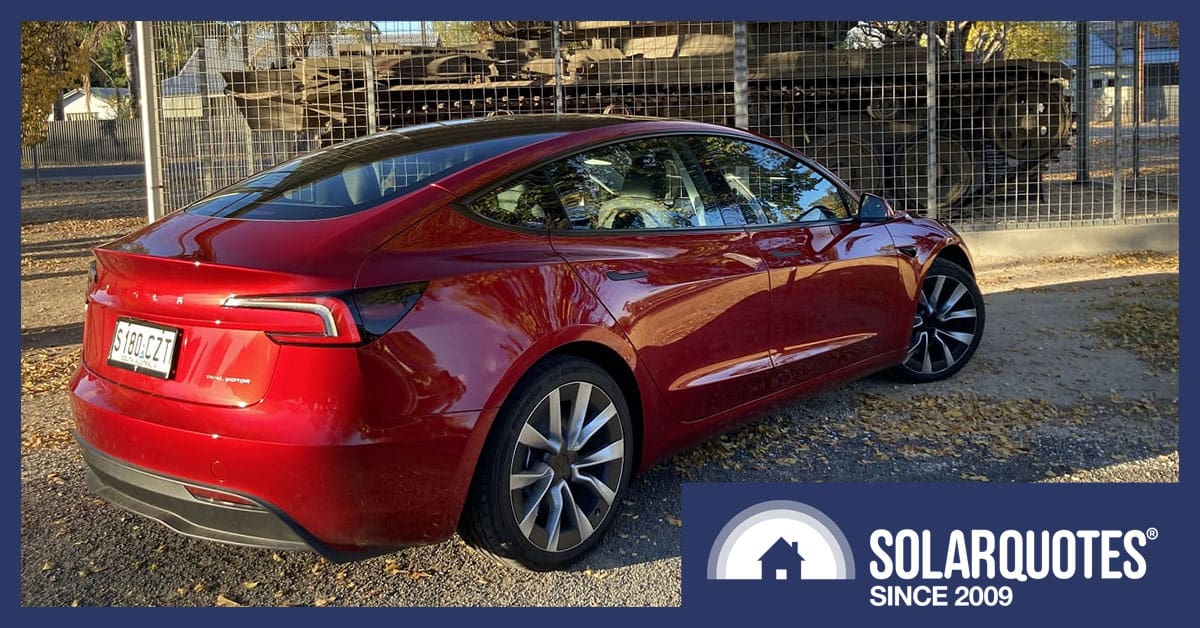
Tired of filling your tank? Go electric!
Last weekend I drove to Naracoorte to check out some holes in the ground. While this may not sound exciting, what made it special was driving there in a brand new “refreshed” Tesla Model 3.
In almost every way but one, the car was great. Perhaps even amazing. However, tragically, I’m unable to give it the coveted title of totes amazeballs. This is due to one annoying penny-pinching design choice I will heartily complain about later. I’ll hold off for now because there are far too many miserable bastards on the internet and I’d much rather go straight to telling you how cool it was using it to tool around South Australia.
A Refreshed Model 3 Long Range All Wheel Drive
If you are wondering why I called it “refreshed”, that simply means it’s the latest upgraded version. Every new Model 3 sold in Australia is now one of these. Its appearance is slightly different. Some say it looks better, and I guess they’re right, but I don’t care what a car looks like. I care what it can do for me. And it can do a lot.
The particular version of Model 3 loaned to me for the weekend was a Long Range All Wheel Drive.
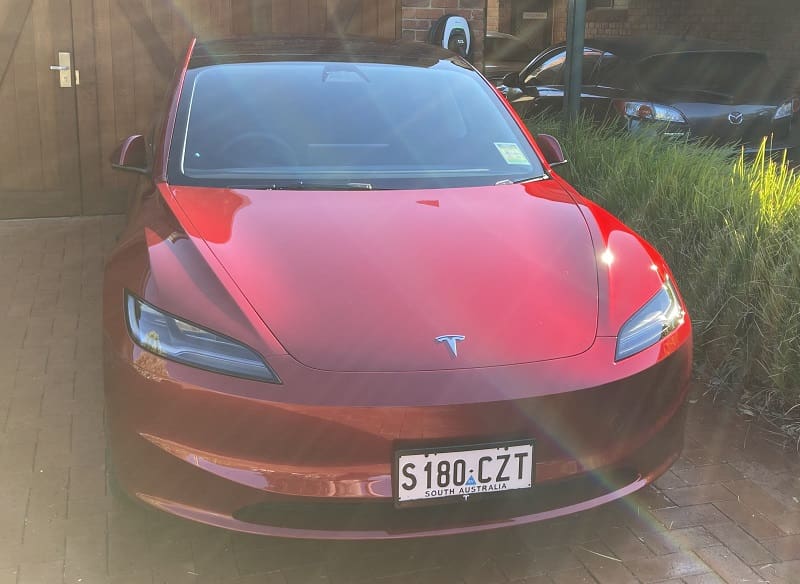
The lens flare is because I went to the J.J. Abrams school of photography.
It has 75 kilowatt-hours (kWh) of usable battery capacity, awesome performance, and drives like a dream – provided you’re the strange sort of person who dreams about driving well made electric cars.
You may be wondering who would be crazy enough to lend this brand new ruby beauty to a short-sighted Santa Clause impersonator who has already publicly admitted to never seeing in 3D before watching the movie Avatar? The answer is – my boss, Finn. He bought this Model 3 for his day-to-day driving and was kind enough to let me try it out.
Finn probably trusted me because, years ago, I borrowed his Tesla Model S and brought it back intact. While it was hit by a giant pelican poop, that was okay because I didn’t tell him. A year later, I took his electric mini for a spin, and the only damage caused was to myself.
At the beginning of 2021 I also drove a non-refreshed Model 3 rental without needing to make a single insurance claim.
The first time I drove a Model 3 I declared it to be my most favorite car ever. While the much more expensive Tesla Model S had clear advantages, they were outweighed by it being much more expensive. The Model 3 won because someday I could realistically hope to buy one second-hand. But over the past few years the cost of Tesla cars has dropped so far that buying a new one is almost within my grasp.
Base Model 3 Is Now 26% Cheaper
The first Model 3 I tried out – three years and four months ago – was this version, the Standard Range Plus…
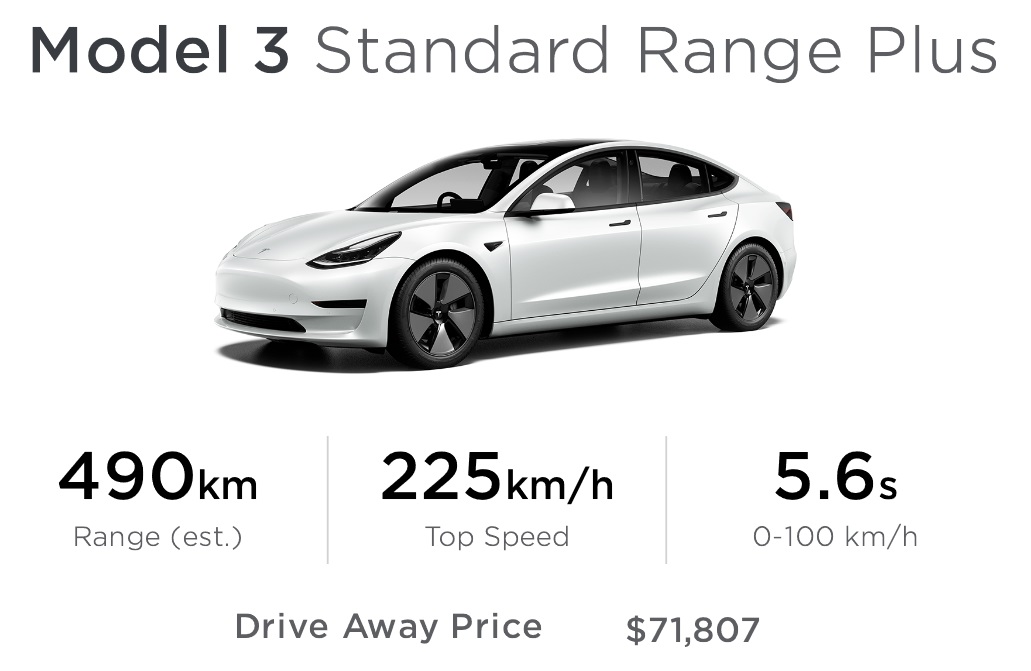
It was the lowest cost Tesla available at the time and – without any extras – would have set you back around $71,800. But if you buy the cheapest Model 3 today today you’ll get this refreshed version:
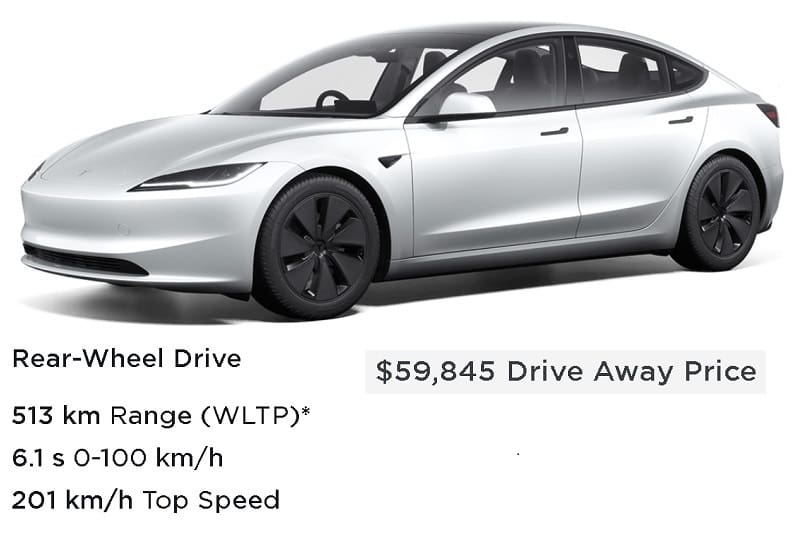
Tesla has just dropped their prices, so this will only cost you around $59,850.
But the two cars aren’t directly comparable. The range of the new one is a little higher while its top speed and acceleration are lower. How much this matters depends on your preferences. Personally, I don’t give a damn about reduced top speed because the fastest you can legally go in Australia is 130km/h. Also, while awesome acceleration is nice to have, it’s not something I need for day-to-day driving.
But even if you’re all about high performance, you may still be impressed by how the new refreshed version is over 25% cheaper.
Those reading this who suffer from compulsive arithmetic disorder are probably now looking at the vehicle prices and yelling, “Wait a minute! Can’t you do basic maths? The new car is only 17% less!” But in real terms – after inflation is accounted for – the new one is around 26% cheaper.
If your income hasn’t kept pace with inflation, that’s terrible. But it doesn’t change the fact EVs are now a lot cheaper than they were three and a bit years ago.
I don’t know if Tesla car prices will continue to fall. But what I do know is if Elon Musk doesn’t keep knocking down his car prices, he’ll end up selling a lot less of them due to stiff competition from China and other countries. But mostly China.
Zero Defects – Not Even Nitpicks
Before getting behind the wheel, I checked over the vehicle while Finn performed essential maintenance. I used the superpowered nitpicking vision I developed after living in Japan for several years. A country where everything fits together well – except for people who like anime. They’re just weird.
Many early Tesla vehicles had hideous manufacturing defects. Some were so bad Kate Moss didn’t have to open the door to get in. She’d just slip between gaps in the panels. But the Model 3 I drove a few years ago – which was made in the USA – looked pretty good. As for this one, it looked perfect. I’m not saying the design can’t be improved, but everything was where it should be without mismatches or anything appearing slightly out of place.
They obviously have excellent quality control in the Tesla Shanghai factory, which is where it came from. While Elon’s main competition is in China, it’s also where a huge number of Tesla vehicles are made.
By the way, I’ll give you the full rundown of the maintenance schedule Finn performed:
- Top up windscreen wiper fluid reservoir.
That was it. It’s all he’ll have to do until the tyres need rotating or changing. At some point the brakes will need to be checked and the pads replaced, but that’s a long way off.
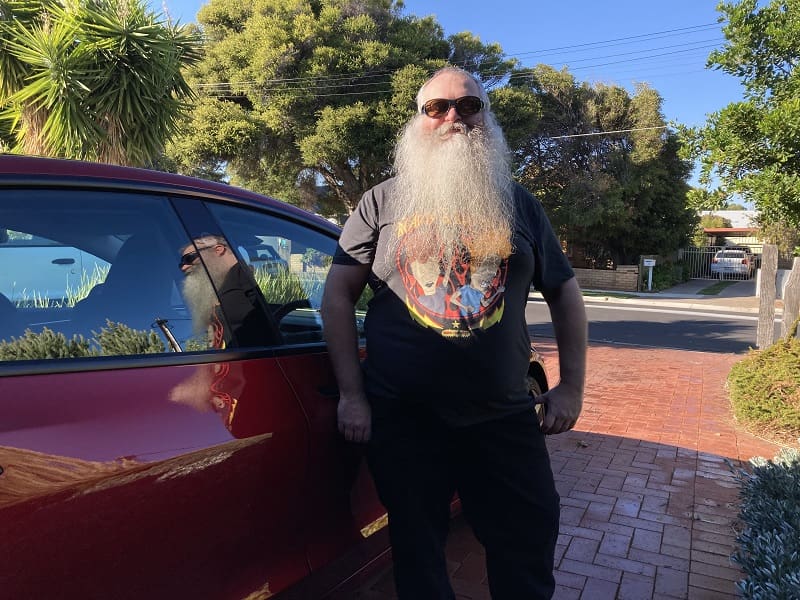
The refreshed Model 3 is an elegant vehicle, so I made sure to dress appropriately.
There’s An App For It
Teslas have a phone app that takes the place of keys. Finn sent me the download link so I could have a seamless, keyless, Tesla experience.
It didn’t work.
I downloaded the 238 megabyte app without a problem but it wouldn’t let me in the car. After spending a few minutes trying to get it to work, Finn sent me the link again, and this time the ones and zeros pulled their act together and gave me keyless access. It has to be keyless because the car has no keyholes. There’s also a card that acts as a key and will let you in and start the vehicle, so you’re not held hostage to your phone battery’s charge.
You Sit Low
Like most EVs, Teslas have a “skateboard” design with batteries in the floor. But despite the undercarriage battery layer, you sit quite low to the road in a Model 3. Not as low as in some sports cars, but definitely lower than in my little Hyundai Getz. This means it takes a bit more effort to get out. While this wasn’t a real problem for me, it will be for some people. Because my father’s spine resembles the lovechild of Swiss cheese and gristle, he could never use this car.
Like all fancy cars these days, the Model 3 remembers your seat and side mirror position preferences. Push button controls allow electric motors to adjust seat positions with a whir that makes them sound undecided, “Ehhhhhhhhhhhh…”
When you put the car in park by swiping your finger on the touchscreen, the front seats move back automatically to make getting out easier.
It Drives Good
Once I finally had my hands on the wheel I gently pressed the accelerator and surged out of the driveway. I immediately went to pick up my friend so we could have a wild weekend… I mean, a sedate, relaxed, and ultra-cautious weekend of carefully evaluating the vehicle. Definitely no wild stuff went on.
The Model 3 Long Range doesn’t just hug the road — it grapples it. There was so much traction it felt as though the planet was pinned to the wheels. While the old Model 3 I drove was good, this was much better thanks to its all wheel drive and heavier battery pack. The only car I’ve driven that gripped the road better was a Tesla S.
Like all Teslas, you feel the bumps more than you’d expect in a car at its price point. This is at least partially because there’s a trade-off between maxing out the range and a smoother ride. But it’s not terrible. I feel the bumps a lot more in my Hyundai.
An improvement is the accelerator is a little firmer, making it easier to stay at a constant speed and avoid accidentally exceeding the limit.
The car’s readouts are all on its touchscreen display. This can seem weird at first, but you get used to it.
Plenty Of Luggage Space
After arriving at my friend’s place, we slung our luggage into the back of the Model 3. It looked like there was plenty of room, but since I’m no boot expert I looked it up and found that, at over 500 litres, there’s more space than nearly all sedans have.
But that’s not all!
Because electric motors are compact there’s also storage space in the front called a frunk. It’s 88 litres. In case you were wondering how many small dogs that is, it’s more than two:
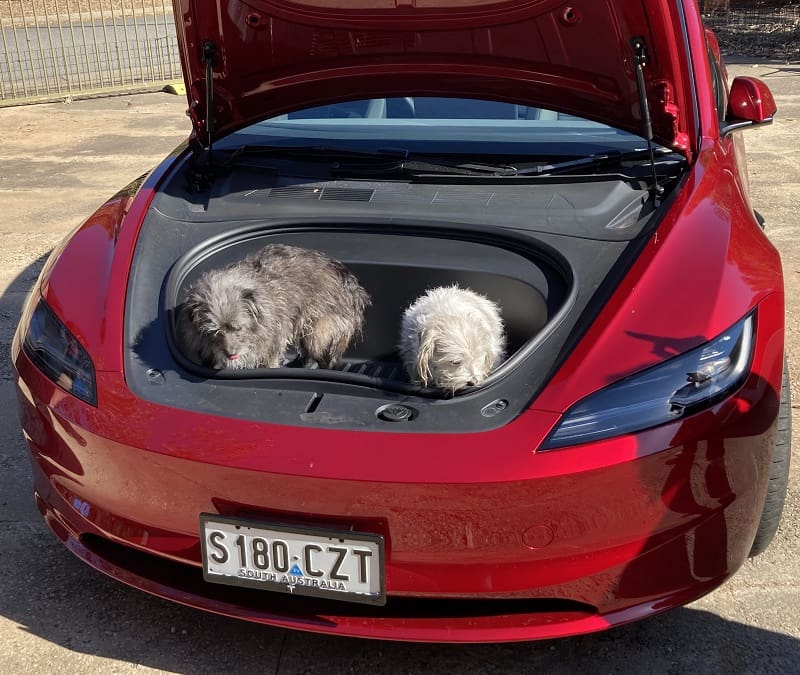
We could probably have fit four small dogs in there and still shut the bonnet. But I would never do that because it would be animal cruelty. So, instead, I put a human in there:
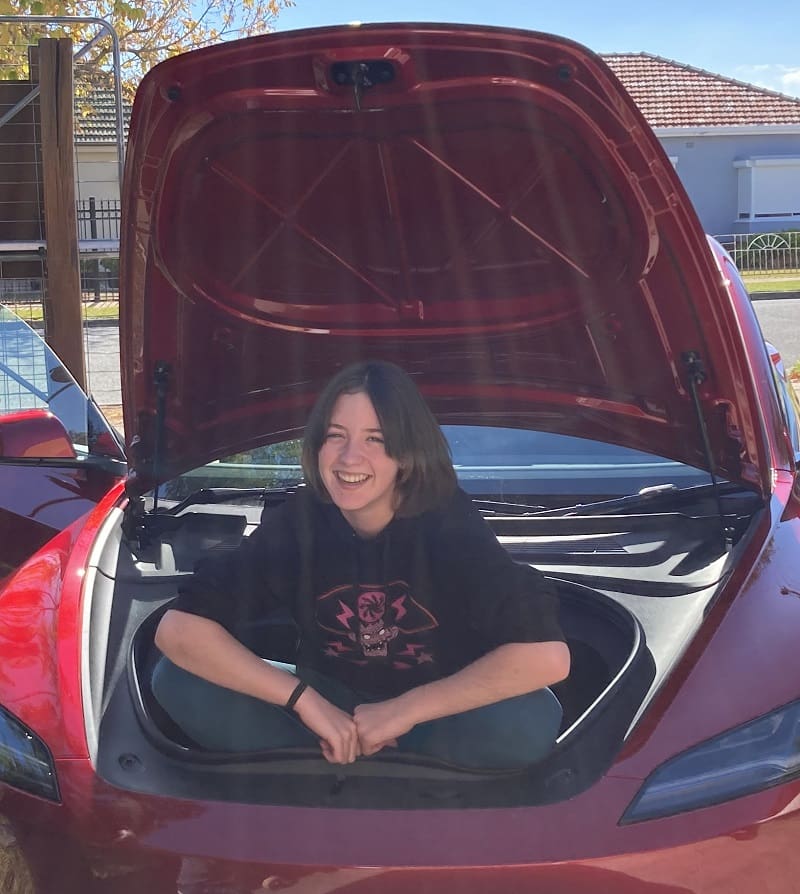
But with her there – no matter how hard her brother tried – we couldn’t get the bonnet shut. So while it will fit a backpack or two, you can’t have a person up front in the frunk.
The frunk sitter’s brother then discovered there was a touch screen for backseat passengers and – in only three minutes – he figured out how to change the car’s settings so it made fart sounds when the indicators were on. A feature apparently installed at the personal request of Elon Musk.
I’m the first to admit I have little respect for Elon. Over the past few years, the amount of time that passes between him saying something either stupid or repugnant has been rapidly decreasing. But then he goes and does something stupid and juvenile like this and totally redeems himself!
But I still recommend disabling the rear touchscreen from affecting car settings any time you have a teenager riding in the back – or Elon Musk.
To my surprise, the teenager returned the indicator sounds to normal when I asked him to and we didn’t end up farting our way to Naracoorte.
Plenty Of Performance
After dropping off the fart master at his place of employment – because all kids want to do these days is work – we headed out to hit the highway.
We hit it at a point where the Adelaide Hills reared up above us. A river of asphalt flowed down them with white dashes delineating a trinity of lanes. Glowing electronic signs informed us we could go at the maximum permitted speed. Unlike when I head up the hills in my 20 year old Hyundai Getz, this time I didn’t think I’d have any problem reaching it.
I mentioned the acceleration of the lowest cost Model 3 isn’t what it used to be. It now accelerates from 0 to 100km/h in 6.1 seconds instead of 5.4 seconds. But I wasn’t in the cheapest Model 3. I was in this:
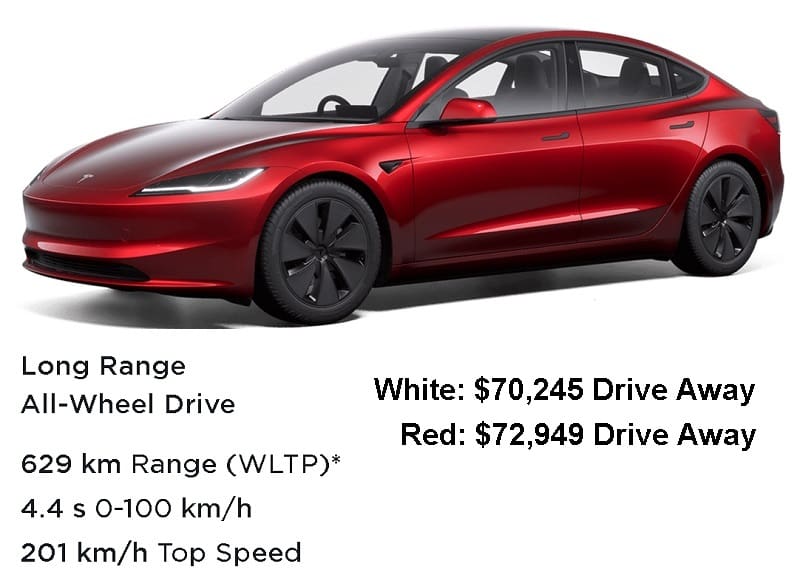
Being red doesn’t make a Tesla Model 3 Long Range All Wheel Drive faster. It just makes it more expensive.
A refreshed Long Range Model 3 that can go from 0 to 100km/h in 4.4 seconds.
Mind you, if I’d been in the lower cost Model 3 that requires 6.1 seconds to accelerate to that speed, I don’t think I would have had any problems. My Hyundai Getz requires 11.2 seconds.
It was Saturday morning, so there was plenty of traffic on the three lanes heading up and through the hills. Most drivers chose the middle lane so they wouldn’t get stuck behind slow movers to the left. But the large number of vehicles meant the middle lane was moving slowly and so the right lane was filling up and wasn’t moving fast either.
After evaluating the situation, I put the Tesla in the left lane because it was the fastest way to go. I passed everyone to my right, and when I came up behind a slow mover such as a semi-trailer or Hyundai Getz, I had so much power at my disposal that changing lanes and getting around them was easy. Because I’m not a complete idiot and kept to the speed limit, I didn’t come close to accelerating as rapidly as the Model 3 Long Range allowed.
If you have plenty of money, you have to get an EV and try this before it becomes commonplace and makes it no longer seem so cool. If you don’t have plenty of money but are still in the market for a new car, even modestly priced EVs usually have good performance. If I was driving the lowest cost Model 3, I don’t think I would have had any difficulty doing what I did.
So Quiet – And So Musical!
Vanessa – my charming and sophisticated travelling companion – decided to play some suitably epic music as an accompaniment to our EV adventure. She did this using the vehicle’s central touch screen and Finn’s Spotify account. Not that she hacked it. Finn let us use it.
I don’t know if the Model 3’s speakers are better or worse than those in similar priced cars, but there are 17 of them and they sound bloody amazing. This is because EVs are so quiet thanks to not running off a rapid series of controlled explosions. The refreshed Model 3 is even better than the older version as it has improved sound reduction features. This makes it great for listening to music or simply having a normal conversation without needing to raise your voice.
In addition – unlike some older Teslas that weren’t so well put together – the vehicle didn’t make a single rattle or squeak, regardless of the speed or road surface. But I don’t actually know what happens at 200km/h. You’ll have to find that out for yourself.
But just because you can barely hear the motor doesn’t mean there’s no noise. Around town in a conventional car, most of the noise comes from the engine. But at highway speeds it’s mostly road noise – the sound of tyres against the road surface and air rushing by. While the refreshed Model 3 dampens this, it still comes through.
If you don’t believe that road noise is normally louder than a petrol or diesel engine on the highway, put a conventional car in neutral and roll down a mountain with the engine off. After you hit about 80km/h you’ll realize there’s a lot of road noise. But before you do this, be sure to fill out a life insurance policy with those who love you as the beneficiaries.
And never forget that I love you.
Internet Ain’t Free
When you buy a Tesla it comes with 8 years of Standard Connectivity. This covers internet for navigation and software updates. If you want more than that, you’ll have to pay for it – as you will with most internet connected cars these days. Tesla charges $10 a month for Premium Connectivity that covers all other internet use, such as backseat passengers watching cat videos on their screen, internet music services, or – purely hypothetically – frantically looking up how to hide scratches on a Model 3 after getting drunk and scraping against a telephone pole.
You get one month of Premium Connectivity for free with a Model 3. After that you’ll need to pay, but if you can afford a new car, there’s probably not much point in skimping on access to cat videos.
No USB-A!
After getting over the Adelaide Hills and cruising down the highway for 50 minutes, we headed to Murray Bridge for lunch. As my phone battery was getting low I decided to give it a charge and discovered that, unlike the Model 3 I drove a few years ago, there were no USB-A ports. Sure, I found heaps of USB-C ports, but nothing that would accept the chunky end of my iPhone 6 USB-A charging cable.
It appears Elon Musk thinks that if you’re funky and trendy enough to buy one of his cars, you are also funky and trendy enough to have a phone charging cable that isn’t 9 years old. It’s not that I was expecting the Model 3 to be full of USB-A ports, but I was expecting at least one to provide backwards capability for backwards people. Unfortunately, I was caught out. Luckily for me, the pub in Murray Bridge was advanced enough to have USB-A plugs. (But not USB-C plugs. This is Murray Bridge we’re talking about.)
There’s a spot below the screen where you can leave your phone while driving. If you place some more advanced phones there the Model 3 will charge them wirelessly. But I wouldn’t know about that because I have an iPhone 6 and Vanessa’s phone is so old I think it was made in the Soviet Union. (While it’s surprisingly light for 1990 Soviet technology, lugging around the 40kg battery pack is annoying.)
The Keith Supercharger
After leaving Murray Bridge behind, we drove 154km to the Keith Supercharger. Note this is a Tesla Supercharger station in the town of Keith and not a Supercharger belonging to some guy called Keith.
When we got there the vehicle’s battery charge was a little under 10%. That was lower than I wanted it to be. I wasn’t worried at any point that we’d run out of range. It’s just I didn’t want Finn to think we were doing anything reckless with his car, such as running it close to flat. I didn’t think he’d mind, but just to be on the safe side I decided not to tell him.
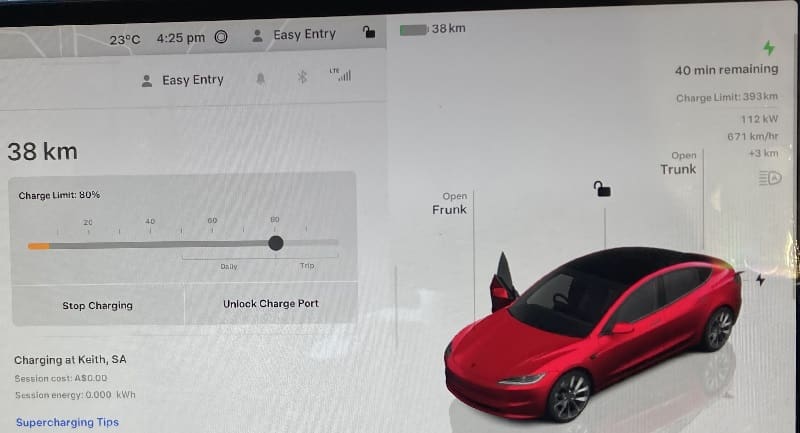
The Model 3 display screen immediately after being plugged into the Keith Supercharger. (The screen isn’t crooked, my photography is.)
I told the car to charge to 80% and it informed me it would take 40 minutes. This amount of time wasn’t a problem for us, but if it seems long to you there are EVs that can charge faster. Also, because batteries charge faster the flatter they are, you can speed things up by only charging enough to safely get to the next Supercharger.
Under ideal conditions, a Model 3 Long Range can gain 282km of range in 15 minutes from a Supercharger. Over that time, with a suitable rapid charger, a Hyundai IQ6 can get up to 358km of range. No doubt, next year, you’ll be able to get an EV that charges even faster – if one isn’t available already.
The last time I took a Model 3 for a spin I had a boot full of different charging cables and adapters. But, unless you’re going off the beaten track, none of that is necessary these days. It wasn’t even necessary three years ago. This time we had a level 2 charging cable in the boot, just in case, but I never touched it. For highway driving all you need to use are Level 3 rapid chargers – whether they are Tesla Superchargers or someone else’s.
When you get to where you’re going, using level 2 destination EV chargers or even a level one charger plugged into a normal power point can make sense, as it can be cheaper – or even free. But they’re not necessary, especially since I wasn’t the one paying the Supercharger fees.
Charging Costs
If I was paying, the Tesla Supercharger would have cost me about 60 cents per kWh. That’s not cheap, but it still works out to less than 9 cents per km. On the highway, my Hyundai Gets gets around 19km to the litre, so at $1.80 a litre, it would come to 9.5 cents a km. This makes a Supercharger cheaper than fueling my little car. If I’d driven a petrol car with performance comparable to the Model 3 Long Range – say an $80,000+ Ford Mustang – it would burn around 20 cents of petrol per km.
But you only Supercharge when it’s convenient. Most of the time you use cheaper ways to charge your car. I happen to know that, with his VPP, Finn has a solar feed-in tariff of 5 cents. With his big 20kW rooftop solar system he can easily charge his car entirely with solar, so the energy we used to get to Keith cost under 1 cent per km. If you don’t have a roof or can’t get solar for some other reason, you can still charge an EV with off-peak rates or use a plan with a special EV rate.
Unlike petrol or diesel cars, EVs get better mileage in town. So, if you only occasionally pay for level 3 rapid charging and have solar panels, you can easily average less than 1 cent per km for “fuel.”
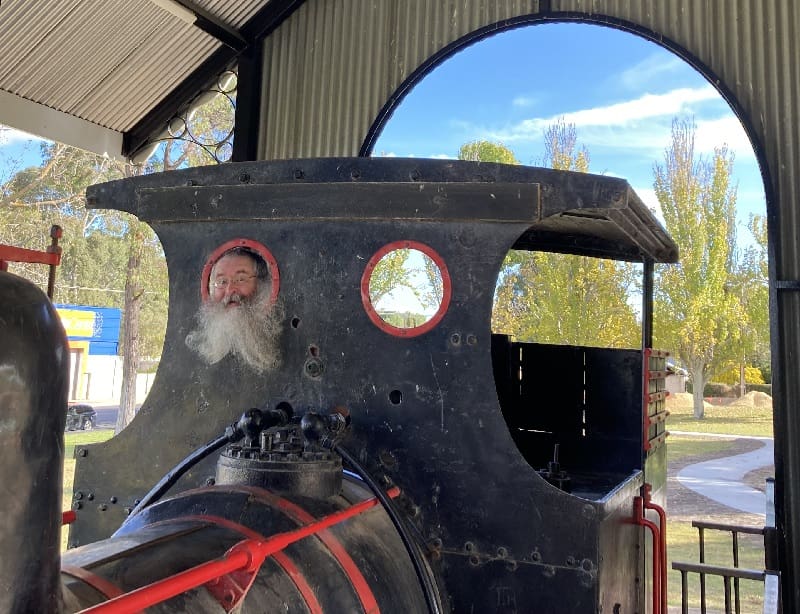
I wanted to compare the Model 3 to a Hydrogen car, but I couldn’t find one. So, instead, I checked out some equally viable technology.
Driver Assist Is… Meh…
Like many cars these days, Teslas have Advanced Driver Assistance. I tried out the basic version they all come with. It wasn’t the “Full Self Driving (Supervised)” only available in the United States that has Americans simultaneously praising and complaining.
Tesla calls its basic driver assist “Autopilot.” This is not a good name because if you don’t pay attention to the road, you will suffer the same horrible consequences you would without it—they just might happen a few seconds later.
While the driver assist has improved from three years ago, I don’t think it has improved enough. I didn’t like it at all in town. I’ve been driving for about 100 years and haven’t had an accident yet, so when the driver assist starts doing things I wouldn’t do, I have a hard time believing it knows better than me.
I kind of liked it on the highway, but I don’t think I can recommend using it – not with a clear conscience.
What I liked about driver assist is – when it’s turned on – the car will look at speed limit signs by the side of the road and automatically travel at the indicated speed. Not needing to worry about accidentally speeding in a high performance vehicle is a good thing. But it doesn’t slow down until after it passes a sign with a lower limit and that’s not what you’re supposed to do in Australia. It also has trouble reading speed limit signs used for road works that are low to the ground. It seemed to mostly guess what they said.
The car’s set speed can be adjusted up or down with a control on the steering wheel. This is useful when it makes a mistake detecting the speed limit or when you’re behind someone who doesn’t consistently stick to one speed. But if you deliberately set it above the speed limit, then I think you’re an idiot. This is because if you have an accident, the police will know what you did because the car records everything. A police officer told me they love being called out to car crashes involving a Tesla because it saves them so much work.
The “autopilot” also automatically steers to keep you in your lane and brakes to prevent you hitting things in front, such as another car. A problem was, every now and then, it would brake when there was nothing to hit. Several times after a car went by in the opposite lane the driver assist would slow down for no reason I could see. The worst incident was when I was going around a curve to the left and a semi-trailer was approaching around the curve in the opposite lane. The driver assist apparently thought we were about to head into the side of the semi rather than follow the road and slammed the brakes on hard. I immediately took back control by turning the wheel, but it was still nerve wracking. It was so bad it took 20 minutes for my nerves to unwrack themselves.
Because of this grand brake slam incident, even though I mostly liked driver assist on the highway, I’m going to recommend not using it because when it does something weird it can create a dangerous situation. If I’d been just a little more shocked I could have easily driven off the road or perhaps just felt regretful for not wearing brown trousers.
But some people love driver assistance, so you can try it and see if it suits you. There are those online who say it’s great for reducing driver fatigue, although some of their claims are so extreme it makes me think they get fatigued way too easily to be allowed behind a wheel.
Danger-roos
Due to mucking around in Adelaide and stopping for lunch, we ended up on the road after sundown. When you’re driving a $73,000 car on the road to Naracoorte, this creates a danger-roos situation. I swear, kangaroos are attracted to new car smell. While hitting a roo wouldn’t be good, I did wonder if the aerodynamic shape of the Model 3 would help it flow over us if it was in mid-jump. But because I didn’t think Finn would appreciate me banging his new Tesla against large hopping fauna, I sat behind another vehicle in the hope they’d take a hit for me. The car behind did the same to us and we ended up doing the Cunnamulla Conga into Narracoorte.

A diprotodon statue at Naracoorte Caves. This picture would be much better if I’d thought to bring a step ladder and a saddle.
Vampire Drain
We stayed at the Country Motor Inn, and it was fine. The bathroom was larger than the entire suite at a Japanese hotel and the bedrooms were a good size. The water pressure wasn’t anything to write home about, but anyone who goes to Naracoorte and writes home about water pressure is a fundamentally boring person. Most importantly, they didn’t have the horrible, worn-out towels many expensive capital city hotels have which are more effective at absorbing your will to live than water.
Just to be on the safe side – or perhaps the dangerous side – I switched off the Model 3’s sentry mode. When on, this automatically records incidents around the vehicle. Usually, it’s just people checking out the car, dogs watering the tyres, or branches being blown by the wind – but it can also catch vandalism and other crimes. While the extra security would have been nice, leaving it on consumes energy, so I switched it off to keep overnight range loss from vampire drain to a minimum.
Because we had a big day planned, we went straight to bed after watching the Japanese anime, “I Was Reincarnated As A Vending Machine“.
Naracoorte Caves
In the morning, we headed to Naracoorte Caves. These are holes in the ground that contain rippling waves of limestone moving at a centimetre per century, intricate fairy castles of fluted stone, and delicate stalagmites and stalactites that appear set to spear Indiana Jones, Lara Croft, or any adventurer foolhardy enough to ignore tour rules.
One of the tour rules is you have to pay to go on a tour. But if you’re in Naracoorte and not flat broke, you have to check them out. Unless, of course, you suffer from mild claustrophobia that grows ever stronger the deeper underground you go, until – at 20 metres deep – you’re struggling to control the raw panic bubbling up within. You think you’ve made it when you see light at the end of the tunnel but end up throwing up on a fossil anyway.
In that case, you probably shouldn’t go there.

Fossil Fools
One thing the Naracoorte Caves are famous for is fossils. Some are hundreds of thousands of years old. If you head deep into the Victoria Fossil Cave, you’ll eventually arrive here:

See those bones? Like the animals that were wrapped around them, vehicles that run off fossil fuels will soon be extinct. This isn’t a maybe thing. It’s happening right now. In China – which is a pretty big country – half of all passenger car sales are now either pure EVs or plug-in hybrids. Australia hasn’t reached that level yet, but 20% of new passenger cars sold are electric. EVs will continue to improve while conventional cars will stay much as they are, so the rate of uptake isn’t going to slow down.
Peak oil – which is when humanity will be at its crudest – is rapidly approaching. With the current growth in EV sales the number of conventional petrol and diesel vehicles in the world is likely to reach its maximum only three years from now. Soon after that, world oil consumption will enter a terminal decline.
Most experts of the type who write big fat reports on the topic say peak oil is at least five years away but – looking at the rate of EV uptake – I’m optimistic it will arrive sooner.
A Range Test
When we were ready to head from Naracoorte back to Keith, I decided to test the Tesla to see how accurately it estimates the amount of range chewed through on the highway.
One thing many aren’t aware of is EVs are the opposite of conventional cars in how they have better range in town than on the highway. According to the European EV Database, in mild weather – the best figure to use for Australian conditions – the Tesla Model 3 Long Range All Wheel Drive gets:
- City driving: 720km (9.6km per kWh)
- Highway: 580km (7.7km per kWh)
That works out to 53% more range per kWh in town. If I look at a less sporty EV, such as the latest Nissan Leaf, its town range is 65% more. This is very different from my Hyundai Getz, which gets 33% more range on the highway.
The EV Database figures assume a temperature of 23 degrees and no air conditioning, so they’re a little better than what you’re likely to get in real life. But provided you mostly stick to driving around town, the official ranges EV manufacturers give – which are also on windshield energy consumption labels – are reasonably accurate.
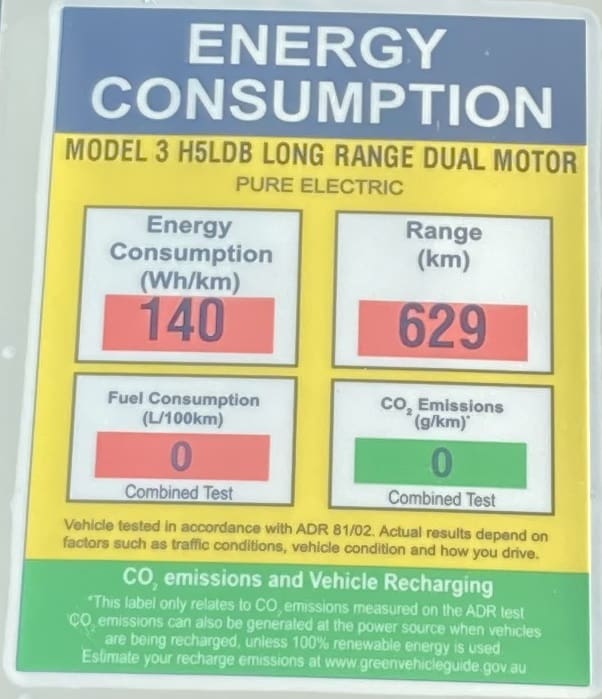
Wait a minute. If the Model 3 Long Range uses 140 watt-hours per km and has 75kWh of usable battery capacity, then it should only be able to do 536km, not 629km! It looks like we need to think harder about what goes on these labels.
To check the Model 3’s range estimate I brought up the car’s navigation system and told it I wanted to go to Keith. You can use voice recognition to do this, but it wasn’t good at understanding me. People make fun of Siri for being a bit of a thickie, but she can work out what I’m saying way better than Tesla navigation. Clearly, Australian accents are just way too sexy for Tesla’s American software to understand.
After tapping in the information, the navigation screen displayed this:
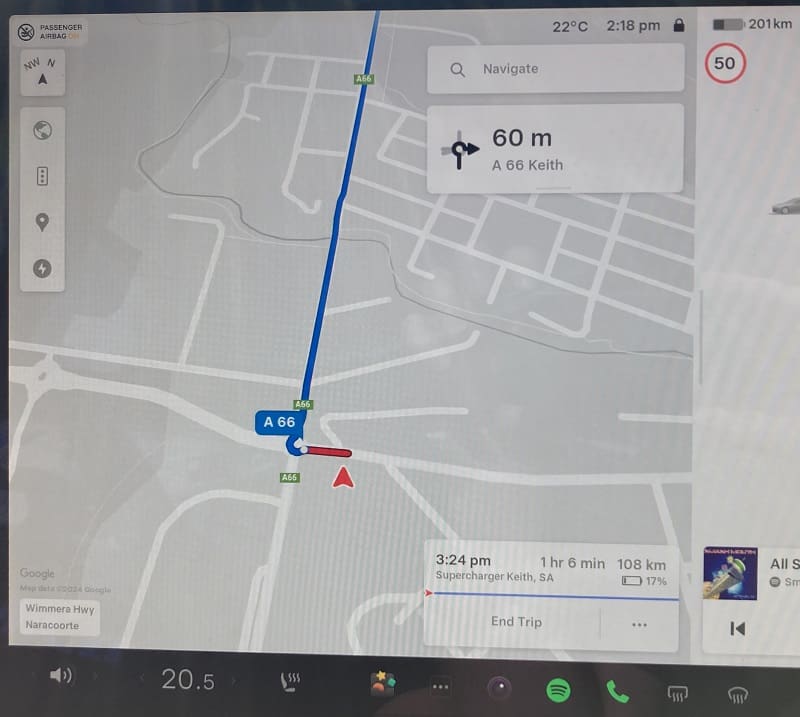
According to this screen, it was 22 degrees, we were 108km from Keith, there were 201km of range remaining, and the battery charge would be 17% when we arrived.
To discover if the car was a liar I pulled out onto the highway. For most of the way we travelled at or close to 110km/h. The air conditioner was on but didn’t need to work hard. The 108km stretch was a pretty typical example of Australian highway driving.
When we arrived in Keith the battery was at 17% – exactly as promised. But the 108km trip reduced our range by 112km. While a little more range was lost than promised, as it was only 4% off I was happy with the result. (And, to be fair, we did have a big lunch.)
Government Range Regulation Required
What would be useful is if Tesla published the average real life range Australian drivers get in their EVs. They could give figures for city and highway driving, as well as a combined cycle. They could also show the difference between careful drivers and lunatics.
Most large EV manufacturers have these precise figures at their fingertips, but they prefer to keep them under their hats in case being honest gives an advantage to less forthright competitors. A simple fix for this conundrum is for the government to require EV manufacturers to publish the information. If everyone has to do it, no one’s at a disadvantage, and it will provide consumers with useful information that will help EV uptake.
The One Giant Flaw Of The Refreshed Model 3
Remember how I said the refreshed Model 3 has a major design flaw? Well, I’ll now mention the stupid decision made by Elon Musk – or at least approved by him – that’s almost bad enough to wipe out all the hard work Tesla engineers put into improving the vehicle.
It desperately needs one of these:
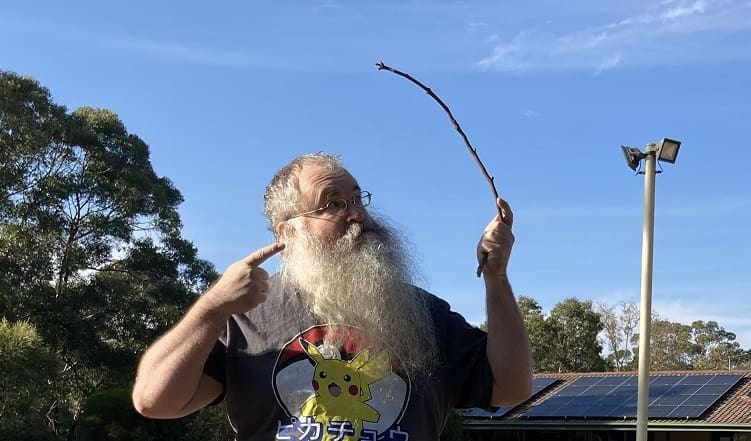
It needs a stick or, to use the technical term, a stalk. It needs one for indicating.
Most cars have two stalks that emerge from behind the steering wheel. Some only have one. The refreshed Model 3 has none. There’s no stick to flick to indicate. Instead, you’re supposed to press buttons built into the steering wheel, which is an atrocious design choice.
When the steering wheel is level, you press the arrow pointing left to indicate a left turn and the arrow pointing right to indicate a right turn. But if the steering wheel is turned a good way to the left or right, then the controls are upside down. This means you have to press the arrow pointing left to indicate turning right and press the arrow pointing right to indicate turning left.
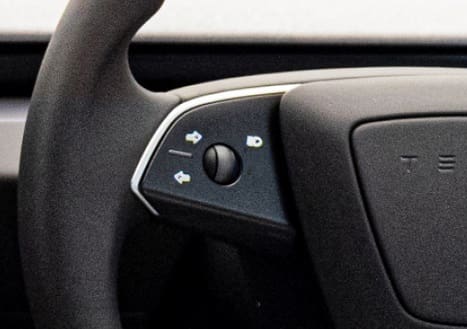
You press the arrows to indicate. Do you think they look easy to use?
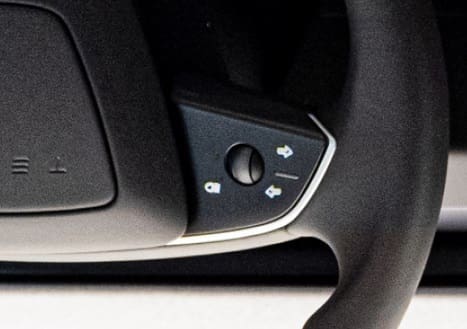
How about now?
Not even Captain Coordination could use this correctly. I found roundabouts were the worst, but it still caused problems in plenty of other situations such as sharp turns and in parking lots.
I know roundabouts aren’t an American thing – they either love you or they bomb you — there’s nothing roundabout about them at all. But I’m still surprised Tesla thought this abomination of an indication system was worth the few bucks per vehicle it saved them. I’m also shocked Australia allows cars with such crappy controls to be driven on roads.
I have two recommendations:
- Tesla: Spend the six bucks or whatever it costs per car for an indicator stalk.
- Australia: Don’t allow cars with lousy controls on our roads.
It’s so hard to indicate correctly that if a police car had been following me around town, I would have racked up enough demerits to lose my licence within half an hour.
According to Model 3 owners you get a little used to it over time, but I doubt it would ever be as comfortable or as safe as using a stalk. If you find it’s not a problem, then it probably means you’re a replicant or something, because I doubt anything human would ever be okay with this.
Apart From That, It’s A Great Car
After using the supercharger in Keith, we made the long trip back to Adelaide and returned Finn’s car without a single scratch on it – that he was able to see in the dim light. We thanked him profusely and got into my Hyundai Getz. Going back to a conventional vehicle was a shock to the system. Don’t get me wrong, it’s a good little car, but it’s no Tesla Model 3.
The refreshed Model 3 is now officially my favourite car, deposing the older version. The Model 3 Long Range All Wheel Drive has definite advantages over the Model 3 Rear Wheel Drive, but it costs around $10,400 more. For this reason I won’t say the Long Range is definitely better. Which is best will come down to your individual needs, desires, and budget.
The lower cost version is more than suitable for my driving needs and may be within my reach after just one more price drop. Of course, if I buy one, there’s no guarantee the price won’t fall further. In fact, I’m sure the price of EVs will continue to drop for years to come. They’ll also improve in quality. For these reasons, a new EV bought today may not be great at holding its value. This is something you’ll need to accept if you get one.
But this is no reason to instead buy a new petrol or diesel car. They will be far worse at holding value. Conventional cars unavoidably require more maintenance, their complex motors need repairs, and — rather than using sunshine to power them — you have to pay to pump their tank full of fossil fuel. No one will want to buy one unless its up-front cost is much lower than an EV, so their values will drop faster.
If you’re in the market for a new car, then I recommend checking out the one I like best. But my favourite could easily change because I haven’t driven many of the latest EVs. Provided I get a chance to try them out, the BYD Seal, Hyundai IQ6, Kia EV6, or something else could soon be my most favorite car ever.
Original Source: https://www.solarquotes.com.au/blog/refreshed-tesla-model-3/

